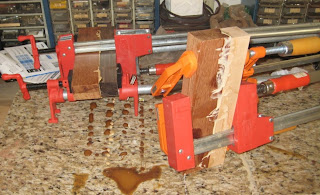I've always enjoyed picnic tables - they are very simple yet can handle years of weather and abuse by their users. As soon as we moved to Dallas I knew that we had to get some outdoor furniture for the back patio and couldn't resist building a picnic table. I went with cedar not only for the beauty of the wood, but also with the hopes that it would last for many years. For the design I wanted to to have a different take on the classic design of a picnic table. To do this I made the table top using slates and a variety of seating options. I finished the outdoor set off with a cedar cooler.
To begin the project I started with the body of the table. First I cut all the slats out of some 1x6 cedar and made the frame with some 2x4s. The long edges of the 2x4s are notched to allow the slats to sit inside them. This allowed the use of just one brace longways under the table and less lumber overall.
After the top I moved on to its footing, working from the top down. I used the traditional slanted legs, overall a very simple structure.
The top is glued on to the base, completing the table. For seating, i always hated benches because they just aren't easy to get up from when there are people sitting next to you. This lead me to use individual benches, using the same design as the top of the table.
In the end I only built the individual seats for one side as I was low on lumber. For the other side I used the same style for a solid bench. Below is the finished project.
**********
The cooler was a random build using leftovers from the table. I built a simple base and surround for the chest, filling the empty space with spray foam and finishing off the top with flat cedar to give it a single unit look.
I cut up the top of the ice chest mounting it to a solid wood top, attached, added some hardware and a brass drain to complete the project.
End.















































